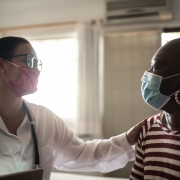Telehealth: Beyond the Scope of Work
With physicians at their fingertips, organizations who have brought on our telehealth technology and services are discovering the true impact of what it means to be a Third Eye Health facility. Although simple to use, the value Third Eye Health brings to our skilled nursing partners goes far beyond common expectations.
Beyond the Scope of Work
The primary function of Third Eye Health serves to bring access to our board-certified physicians on nights, weekends, and holidays when attending physicians are on call and unable to lay eyes on patients. Using our secure telehealth technology via an iPad, nurses connect with Third Eye Health physicians in less than two minutes who, on most occasions, treat patients in place without a transfer to the ED and the added risk of an unnecessary readmission. While treating in place is the core objective when becoming a Third Eye Health facility, there are several additional benefits to appreciate.
Transfer Preparation
While Third Eye Health physicians do have a 90% treat in place record, there are times when our doctors will recommend an acute care transfer due to the circumstances of the consultation. On such occasions, our physicians may stay online with the nurse through the iPad, assisting in the preparation of the transfer. If necessary, our physicians can assist the staff nurse with additional orders that could include oxygen, nitro to mentions a few common orders. Our physicians also can communicate directly with the paramedics when they arrive, relaying pertinent details if needed.
Risk Mitigation
Following each Third Eye Health coverage period, each facility receives a summary of every encounter, alerting the Director of Nursing and the attending physician of any activity that occurred with each patient. Beyond a simple summary, our Care Coordination Managers, who are all nurses by trade, apply a high level of scrutiny while reviewing each case. They take the time to look at patient medical history, especially in cases that raise flags of concern. This is an invaluable service. Our Care Coordination Managers serve as an extra line of defense, providing a second set of eyes for DONs and nurse leaders to review patient encounters and find areas for improvement, for the center, and for the Third Eye Health physicians who are consulting patients.
Case Study: Initiating Plans of Correction
Extension of the Clinical Team
Each Care Coordination Manager works closely with their centers. Following every Third Eye Health physician encounter, the Care Coordination Manager reviews the progress notes and orders conducting quality analysis checks, ensuring all orders are signed and notes are complete. Center Directors of Nursing and attending physicians rely heavily on the daily care summaries provided by their Care Coordination Manager to understand the care their patients received while on our watch. In addition to care summaries, the Care Coordination Manager also establishes a regular metric review, bringing together the center’s clinical leadership time to collaborate on improving care based on the metrics presented. In some instances, they may review a particular case, or in others the Care Coordination Manager may find reoccurring issues in her metrics that may need to be addressed and work together to establish new protocols that would better serve the patient population.



